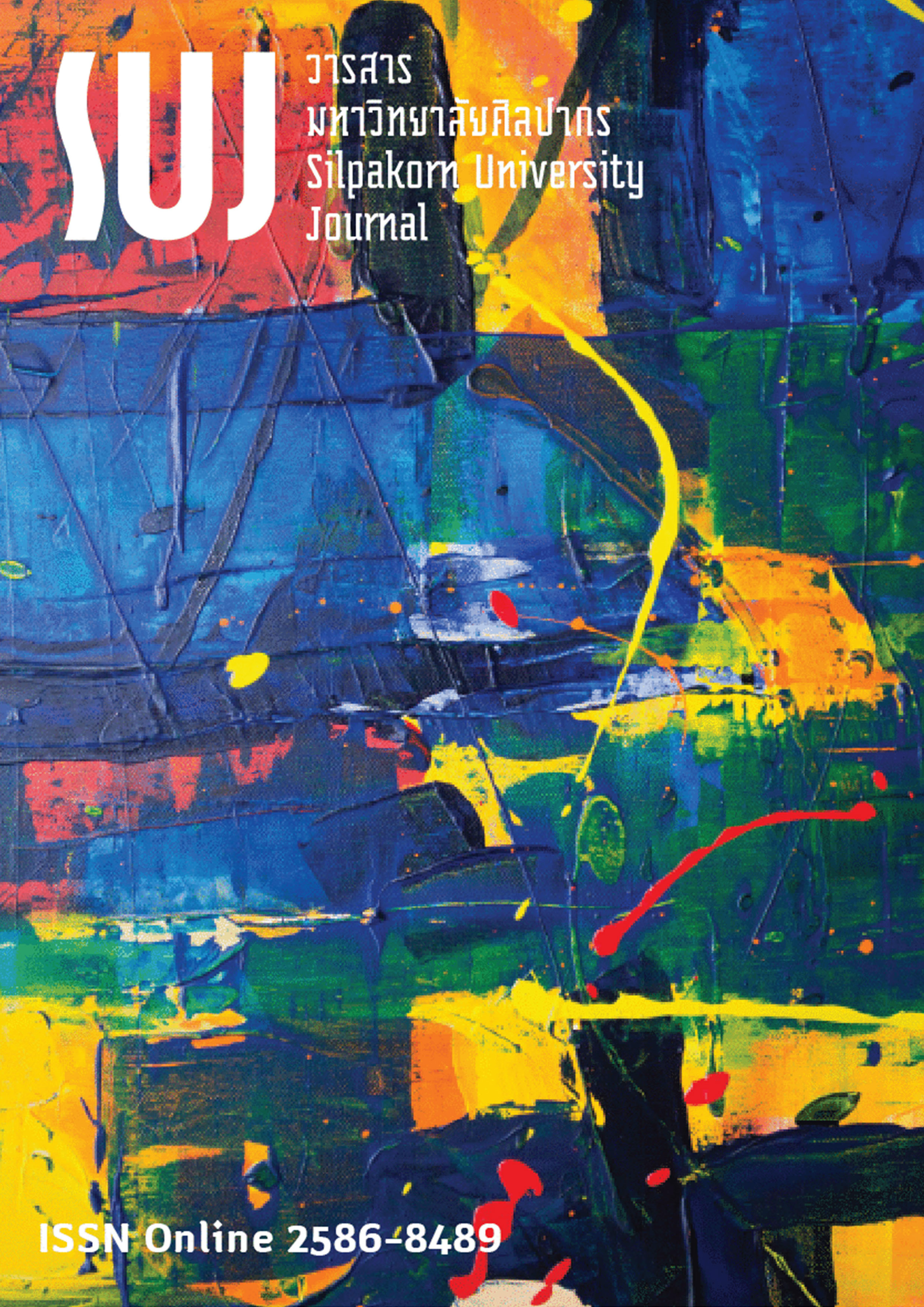การศึกษาหน้าที่ทางวากยสัมพันธ์กับคำที่ปรากฏร่วมกับคำ “Pandemie” (โรคระบาด) และ “COVID-19” ในข่าวประชาสัมพันธ์ภาษาเยอรมันของบริษัทไบออนเทค (A study of syntactic functions and collocations of “Pandemie” (Pandemic) and “COVID-19” in German press releases of BioNTech)
Main Article Content
Abstract
งานวิจัยนี้มีวัตถุประสงค์เพื่อศึกษาหน้าที่ทางวากยสัมพันธ์และคำที่ปรากฏร่วมกับคำว่า “Pandemie” (โรคระบาด) และ “COVID-19” ในภาษาเยอรมัน โดยศึกษาวิเคราะห์ใน 4 ด้าน คือ หน้าที่ทาวากยสัมพันธ์ ภาคแสดงที่ปรากฏร่วม ส่วนขยายที่ปรากฏร่วม และการใช้ในรูปแบบคำประสม ข้อมูลที่ใช้ศึกษามาจากข่าวประชาสัมพันธ์ภาษาเยอรมันที่เผยแพร่โดยบริษัทไบออนเทค ตั้งแต่ปี 2563 ถึง 2564 และใช้โปรแกรม Sketch Engine เป็นเครื่องมือทางภาษาศาสตร์ในการตรวจสอบข้อมูล ผลการศึกษาพบว่า ทั้งคำว่า “Pandemie” และ “COVID-19” มีลำดับความถี่การปรากฏในหน้าที่ทางวากยสัมพันธ์เหมือนกัน คือ ทำหน้าที่เป็นส่วนขยาย กรรม ประธาน และหน่วยวิเศษณ์ ตามลำดับ ภาคแสดงและส่วนขยายที่ปรากฏร่วมกับสองคำนี้ มีความหมายในเชิงของสาเหตุ ความรุนแรง ผลกระทบ และการรับมือโรคระบาด โดยคำกริยาที่ปรากฏร่วมกับคำ Pandemie ที่มีความถี่สูงสุด คือ Beenden (ทำให้จบสิ้น) และคำกริยาที่ปรากฏร่วมกับคำ COVID-19 เป็นจำนวนมากที่สุด คือ Verursachen (เป็นสาเหตุ) ส่วนขยายที่ปรากฏร่วมกับคำ Pandemie เป็นจำนวนมากที่สุด คือ Verheerend (ที่ทำลายล้าง) ในขณะที่ไม่มีส่วนขยายปรากฏร่วมกับคำ COVID-19 แต่คำนี้มักใช้เป็นส่วนขยายในรูปแบบคำประสมแทน นอกจากนี้ยังพบว่า รูปแบบคำประสมที่มีการใช้มากที่สุด คือ “COVID-19-X” งานวิจัยนี้จะเป็นประโยชน์ต่อการวิจัยต่อไปสำหรับผู้ที่มีความสนใจที่จะศึกษาภาคแสดงและส่วนขยายที่ปรากฏร่วมกับคำในสื่อประเภทอื่น ๆ และช่วยให้ผู้ที่เรียนภาษาเยอรมันในฐานะภาษาต่างประเทศเข้าใจการใช้คำที่ปรากฏร่วมกันได้ดีขึ้น
This research aims to study the syntactic functions and collocations of the words “Pandemie” (pandemic) and “COVID-19” in the German language. The analysis covers four aspects: syntactic functions, co-occurring predicates, co-occurring attributes, and the usage of these two words in compound forms. The data used for this study were extracted from German press releases published by BioNTech from 2020 to 2021, with the Sketch Engine employed as a linguistic tool for data validation. The results of the study indicate that both the words “Pandemie” and “COVID-19” have similar frequencies in their syntactic functions, serving as attributes, objects, subjects, and adverbials, respectively. The co-occurring predicates and attributes associated with these two words signify causes, severity, impacts, and response of this pandemic. The most frequent verb collocated with “Pandemie” is “beenden” (to finish), and the verb that appears most frequently with “COVID-19” is “verursachen” (to cause). Additionally, the attribute that appears most frequently with “Pandemie” is “verheerend” (devastating), while there is no co-occurring attribute with the word “COVID-19” as it is often used as a modifying part in compound words instead. Moreover, it was found that the most frequent compound form is “COVID-19-X”. The findings will be beneficial for further studies for those interested in analyzing the co-occurring predicates and attributes of words in other types of media. It will also help learners of German as a foreign language better understand the usage of collocated words.
Downloads
Article Details

This work is licensed under a Creative Commons Attribution-NonCommercial-NoDerivatives 4.0 International License.
References
Aroonmanakun, Wirote. (2010). Corpus Linguistics: Principles and Uses (ภาษาศาสตร์คลังข้อมูล: หลักการและการใช้) (2nd ed.). Bangkok: Chulalongkorn University Press.
Chaimongkol, Thisakon. (2020). Study of collocation occurrence in English essay writing: The case study of three northern university (การศึกษาคำปรากฏร่วมในงานเขียนภาษาอังกฤษของผู้เรียนชาวไทย: กรณีศึกษามหาวิทยาลัยในภาคเหนือ 3 แห่ง). Humanities and Social Sciences Journal of Graduate School, Pibulsongkram Rajabhat University, 14(2): 578-592.
Dechawongse, Saneh, Phra Maha Nyanaviro, Wirote, & Phra Maha Mahaviro, Samak. (2021). COVID-19: Change in the Thai language (โควิด-19: การเปลี่ยนแปลงในภาษาไทย). Journal of Educational Review Faculty of Educational in MCU, 8(2): 410-420.
Durco, P. (Ed.). (2016). Collocation Research and Collocation Didactic (Kollokationsforschung und Kollokationsdidaktik). Wien: LIT. [in German]
Jajetic, A. (2022). Collocations in GFL-classroom Using the Example of the School Lexicon (Kollokationen im DaF-Unterricht am Beispiel der Schullexik). Master’s dissertation, University of Rijeka, Rijeka, Croatia. [in German]
Jitsuchon, Somchai. (2021). The Social Impact of the COVID-19 Outbreaks and Measures That Should be Taken (ผลกระทบทางสังคมของการระบาดโรคโควิด-19 ระลอกใหม่และมาตรการที่ควรมี). Thailand Development Research Institute. [Online]. Retrieved December 18, 2021 from https://tdri.or.th/2021/01/Impact-of-new-covid-19-wave/
Junjoem, Phasinee, & Palanukulwong, Thanyapa. (2017). Effectiveness of lexical collocation instruction on students’ collocation knowledge (ประสิทธิผลของการสอนคำปรากฏร่วมประเภทคำศัพท์ต่อความรู้ด้านคำปรากฏร่วมของนักเรียน). Journal of Yala Rajabhat University, 12(Suppl.): 112-125.
Kaewphat, Suphat. (2017). Language and Society (ภาษากับสังคม). Udon Thani: Faculty of Humanities and Social Sciences, Udon Thani Rajabhat University.
Karadavut, Y. (2021). Contrastive analysis of somatic collocations in German and Turkish (Kontrastive Analyse zu somatischen Kollokationen im Deutschen und Türkischen). Diyalog, 2: 576-590. [in German]
Kovbasyuk, L. (2021). Corona pandemic vocabulary in Contemporary German and Contemporary Ukrainian (Coronapandemie-Wortschatz im Gegenwartsdeutschen und Gegenwartsukrainischen). Studies about Languages, 38: 81-98. [in German]
Lipavic Oštir, A. (2010). Genitive (Genitiv). In E. Hentschel (Ed.), German Grammar (Deutsche Grammatik), (pp. 99-104). Berlin: De Gruyter. [in German]
Möhrs, C. (2021). A Web of Words Unfolds Around Corona (Ein Wortnetz entspinnt sich um Corona). In A. Klosa-Kückelhaus (Ed.), Language in the Corona Crisis: More Dynamic Change in Lexicon and Communication (Sprache in der Coronakrise: Dynamischer Wandel in Lexikon und Kommunikation), (pp. 34-36). Mannheim: IDS-Verlag. [in German]
Mweri, J. (2021). Corona virus disease (COVID-19) effects on language use: An analysis of neologisms. Linguistics and Literature Studies, 9(1): 36-47.
PakornR. (2020). 5 Impacts of COVID-19 in 2020 (รวม 5 ผลกระทบโควิด-19 ในปี 2020). trueID. [Online]. Retrieved December 18, 2021 from https://news.trueid.net/detail/VGJ91QAkKvqN
Pintye, E. (2020). Contrastive collocation German-Hungarian (Kollokationen kontrastiv Deutsch-Ungarisch). Werkstatt, 15: 45-62. [in German]
Reder, A. (2006). Collocation research and collocation didactic (Kollokationsforschung und Kollokationsdidaktik). Linguistik Online, 28(3): 157-176. [in German]
Stojic, A., & Stiglic, T. (2011). Collocations in the German-Croatian comparison (Kollokationen im deutsch-kroatischen sprachvergleich). Jezikoslovlje, 12(2): 263-282. [in German]
Targónska, J. (2018). From text to exercise. Collocations in reading texts and their reflection in exercises (Using selected GFL textbooks as example) (Vom Text zur Übung. Kollokationen in Lesetexten und ihre Widerspiegelung in Übungen (am Beispiel ausgewählter DaF-Lehrwerke)). Linguistik Online, 89(2): 51-81. [in German]
The Standard Team. (2020). Getting to Know the COVID-19 Vaccine of Pfizer and BioNTech After Preliminary Analysis Showing over 90% Anti-Virus Effectiveness (ทำความรู้จักวัคซีนโควิด-19 ของ Pfizer และ BioNTech หลังผลวิเคราะห์ขั้นต้นชี้ประสิทธิภาพป้องกันไวรัสกว่า 90%). [Online]. Retrieved December 18, 2021 from https://thestandard.co/pfizer-and-biontech-covid-19-vaccines


